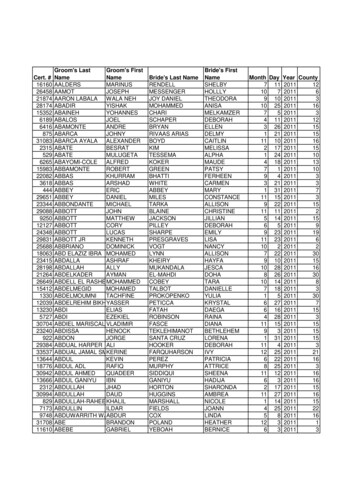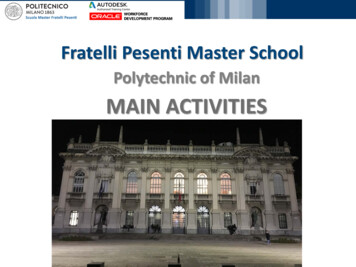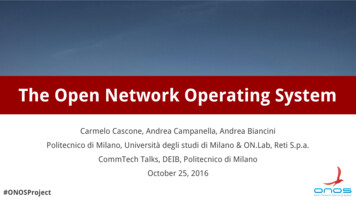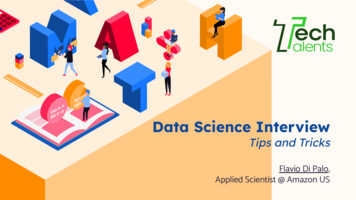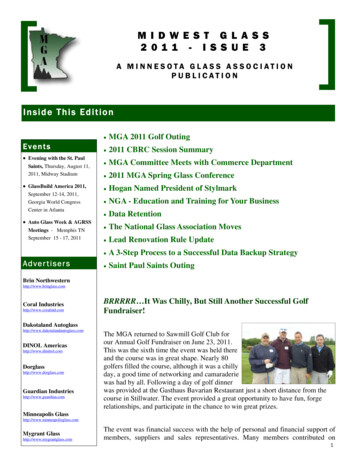
Transcription
ICAART 2011Proceedings of the3rd International Conference onAgents and Artificial IntelligenceVolume 2Rome, ItalyJanuary 28 - 30, 2011Sponsored byINSTICC – Institute for Systems and Technologies of Information, Controland CommunicationIn Cooperation withAPPIA – Associação Portuguesa para a Inteligência ArtificialAEPIA – Asociación Española de Inteligencia ArtificialAAAI – Association for the Advancement of Artificial Intelligence
Copyright c 2011 SciTePress – Science and Technology PublicationsAll rights reservedEdited by Joaquim Filipe and Ana FredPrinted in PortugalISBN: 978-989-8425-41-6Depósito Legal: insticc.org
B RIEF C ONTENTSI NVITED S PEAKERS . . . . . . . . . . . . . . . . . . . . . . . . . . . . . . . . . . . . . . . . . . . . . . . . . . . . . . . . . . . . . . . . . IVO RGANIZINGANDS TEERING C OMMITTEES . . . . . . . . . . . . . . . . . . . . . . . . . . . . . . . . . . . . . . . . . . . VP ROGRAM C OMMITTEE . . . . . . . . . . . . . . . . . . . . . . . . . . . . . . . . . . . . . . . . . . . . . . . . . . . . . . . . . . . . . . VIAUXILIARY R EVIEWERS . . . . . . . . . . . . . . . . . . . . . . . . . . . . . . . . . . . . . . . . . . . . . . . . . . . . . . . . . . . . . . XS ELECTED PAPERS B OOK . . . . . . . . . . . . . . . . . . . . . . . . . . . . . . . . . . . . . . . . . . . . . . . . . . . . . . . . . . . . . XF OREWORD . . . . . . . . . . . . . . . . . . . . . . . . . . . . . . . . . . . . . . . . . . . . . . . . . . . . . . . . . . . . . . . . . . . . . . . . . XIC ONTENTS . . . . . . . . . . . . . . . . . . . . . . . . . . . . . . . . . . . . . . . . . . . . . . . . . . . . . . . . . . . . . . . . . . . . . . . . XIIIIII
I NVITED S PEAKERSCristiano CastelfranchiInstitute of Cognitive Sciences and Technologies (ISTC)ItalyBoi FaltingsEcole Polytechnique Federale de Lausanne (EPFL)SwitzerlandDidier DuboisInstitut de Recherche en Informatique de Toulouse (IRIT)FranceMark KleinMIT Center for Collective IntelligenceU.S.A.Klaus FischerAgents and Simulated Reality, DFKI GmbHGermanyIV
O RGANIZING AND S TEERING C OMMITTEESC ONFERENCE C HAIRAna Fred, Technical University of Lisbon / IT, PortugalP ROGRAM C HAIRJoaquim Filipe, Polytechnic Institute of Setúbal / INSTICC, PortugalP ROCEEDINGS P RODUCTIONHelder Coelhas, INSTICC, PortugalAndreia Costa, INSTICC, PortugalPatrícia Duarte, INSTICC, PortugalBruno Encarnação, INSTICC, PortugalLiliana Medina, INSTICC, PortugalRaquel Pedrosa, INSTICC, PortugalVitor Pedrosa, INSTICC, PortugalJosé Varela, INSTICC, PortugalCD-ROM P RODUCTIONFrederico Fernandes, INSTICC, PortugalPedro Varela, INSTICC, PortugalG RAPHICS P RODUCTIONANDW EBDESIGNERDaniel Pereira, INSTICC, PortugalS ECRETARIATPatrícia Alves, INSTICC, PortugalW EBMASTERSérgio Brissos, INSTICC, PortugalV
P ROGRAM C OMMITTEEMohsen Afsharchi, University of Zanjan, Iran,Islamic Republic ofThomas Ågotnes, University of Bergen, NorwayEgon L. van den Broek, Human-CenteredComputing Consultancy / University of Twente /Radboud UMC Nijmegen, The NetherlandsUniversidad De Los Andes,Joost Broekens, MMI, Delft University ofTechnology, The NetherlandsNatasha Alechina, University of Nottingham, U.K.Giacomo Cabri, Università di Modena e ReggioEmilia, ItalyFrédéric Amblard,Capitole, FranceSilvia Calegari, Universita’ Degli Studi Di MilanoBicocca, ItalyJose Aguilar,VenezuelaUniversitéToulouse1Plamen Angelov, Lancaster University, U.K.Costin Badica, University of Craiova, RomaniaValérie Camps, IRIT - Université Paul Sabatier,FranceAntonio Bahamonde, Universidad de Oviedo,SpainJose Jesus Castro-schez, Escuela Superior deInformatica, SpainMike Barley, University of Auckland,New ZealandGeorgiosChalkiadakis,Southampton, U.K.Roman Barták, Charles University in Prague,Czech RepublicKe Chen, The University of Manchester, U.K.Teresa M. A. Basile, Università degli Studi di Bari,ItalyUniversityofHo-Jin Choi, Korea Advanced Institute of Scienceand Techonology (KAIST), Korea, Republic ofPaolo Ciancarini, University of Bologna, ItalyAna Lúcia C. Bazzan, UFRGS, BrazilSilvano Cincotti, University of Genoa, ItalyOrlando Belo, University of Minho, PortugalDiane Cook, Washington State University, U.S.A.Christoph Benzmueller,U.S.A.Gabriella Cortellessa, ISTC-CNR, ItalyArticulate Software,Greet Vanden Berghe, KaHo St.-Lieven, BelgiumPaulo Cortez, University of Minho, PortugalCarole Bernon, University of Toulouse III, FranceMassimo Cossentino, National Research Council,ItalyDaniel Berrar, Tokyo Institute of Technology,JapanDarryl N. Davis, University of Hull, U.K.Ateet Bhalla, NRI Institute of Information Scienceand Technology, IndiaReinaldo Bianchi, Centro Universitario da FEI,BrazilSander Bohte, CWI, The NetherlandsEnrique Bonsón, Universidad de Huelva, SpainTibor Bosse, Vrije Universiteit Amsterdam,The NetherlandsYves Demazeau, CNRS, FranceAndreas Dengel, German Research Center forArtificial Intelligence (DFKI GmbH), GermanyGaël Dias, University of Beira Interior, PortugalFrank Dylla,GermanySFB/TR 8 Spatial Cognition,Stefan Edelkamp, Universität Bremen, GermanyAlessandro Farinelli, University of Verona, ItalyDjamel Bouchaffra, Oakland University, U.S.A.Danielle Boulanger, Université Jean Moulin Lyon3, FrancePaolo Bresciani, European Commission, BelgiumVIMaria Fasli, University of Essex, U.K.Nazim Fatès, LORIA - INRIA Nancy Grand-Est,France
P ROGRAM C OMMITTEE ( CONT.)Stefano Ferilli, Universite of Bari, ItalyMarc-Philippe Huget,Polytech’Savoie, FranceAntonio Fernández-Caballero, Universidad deCastilla-la Mancha, SpainLuis Iribarne, University of Almería, SpainEdilson Ferneda, Catholic University of Brasília,BrazilFuyuki Ishikawa, National Institute of Informatics,JapanRoberto Flores, Christopher Newport University,U.S.A.Wojtek Jamroga, ClausthalTechnology, GermanyClaude Frasson, University of Montreal, CanadaPaulo R. Ferreira Jr., Universidade Federal dePelotas, BrazilNaoki Fukuta, Shizuoka University, JapanWai-Keung Fung, University of Manitoba, CanadaAlessandro Garcia, Pontifical Catholic Universityof Rio de Janeiro, BrazilArnulfo Alanis Garza, Instituto Tecnologico deTijuana, MexicoJoseph Giampapa, Carnegie Mellon University,U.S.A.Maria Gini, University of Minnesota, U.S.A.Madhu Goyal, University of Technology, Sydney,AustraliaDominic Greenwood, Whitestein TechnologiesAG, SwitzerlandSven Groppe, University of Lübeck, GermanyRenata Guizzardi, Federal University of EspiritoSanto (UFES), BrazilKasper Hallenborg,Denmark, DenmarkUniversity of SouthernofMatthias Klusch, Deutsches Forschungszentrumfür Künstliche Intelligenz, GermanyFernando Koch, Universiteit Utrecht, AustraliaMartin Kollingbaum, University of Aberdeen,U.K.Sébastien Konieczny, CNRS - CRIL, FranceIgor Kotenko, St.Petersburg Institute forInformatics and Automation of the RussianAcademy of Science, Russian FederationYau-Hwang Kuo, National Cheng kung University,TaiwanCentral Connecticut StateMichail Lagoudakis, Technical University ofCrete, GreeceLuis C. Lamb, Universidade Federal do RioGrande do Sul, BrazilAnna T. Lawniczak, University of Guelph, CanadaPedro Henriques, University of Minho, PortugalAndreas Herzig, Université Paul Sabatier &CNRS, FranceWladyslaw Homenda, Warsaw University ofTechnology, PolandWei-Chiang Hong,Technology, TaiwanUniversityFranziska Klügl, Örebro University, SwedenStan Kurkovsky,University, U.S.A.Eric Gregoire, Universite d Artois, FranceUniversity of Savoie,OrientalMarkHoogendoorn,VrijeAmsterdam, The NetherlandsInstituteofUniversiteitEnda Howley, National University of Ireland,Galway, IrelandHo-fung Leung, The Chinese University of HongKong, Hong Kong, ChinaStanley Loh, UCPEL, BrazilStephane Loiseau, Leria, FranceNoel Lopes, IPG, PortugalBernd Ludwig, University of Erlangen-Nürnberg,GermanyJosé Machado, University of Minho, PortugalNicola Di Mauro, Università di Bari, ItalyBenito Mendoza, ExxonMobil Research andEngineering, U.S.A.VII
P ROGRAM C OMMITTEE ( CONT.)Marjan Mernik, University of Maribor, SloveniaBernd Meyer, Monash University, AustraliaAmbra Molesini, Alma Mater Studiorum Università di Bologna, ItalyHaralambos Mouratidis,London, U.K.Berndt MüllerGlamorgan, U.K.University of EastRamalingam Ponnusamy, Vinayaga MissionsUniversity, IndiaPetrica Pop, North University of Baia Mare,RomaniaDaowen Qiu, Sun Yat-sen University, China(Farwer),UniversityofChristian Müller-Schloer, Leibniz UniversitätHannover, GermanyNysret Musliu, Vienna University of Technology,AustriaOsakaRong Qu, University of Nottingham, U.K.Franco Raimondi, Middlesex University, U.K.Luís Paulo Reis, FEUP/LIACC - Faculdade deEngenharia da Universidade do Porto, PortugalofAlessandro Ricci, Alma Mater Studiorum Università di Bologna, ItalyPrefectureM. Birna van Riemsdijk, Delft University ofTechnology, The NetherlandsRadhakrishnan Nagarajan,UniversityArkansas for Medical Sciences, U.S.A.Tomoharu Nakashima,University, JapanEric Platon, National Insititute of Informatics,JapanDaniel Rodriguez, University of Alcalá, SpainJens Nimis, FZI Forschungszentrum InformatikKarlsruhe, GermanyJuha Röning, University of Oulu, FinlandLuis Nunes, Instituto Superior de Ciências doTrabalho e da Empresa, PortugalRosaldo Rossetti, Laboratório de CC/FEUP, PortugalAndreas Oberweis, KarlsruheTechnology (KIT), GermanyFariba Sadri, Imperial College London, U.K.InstituteofMichel Occello, Université Pierre-Mendès-France,FranceManuel Filipe Santos, University of Minho,PortugalJohn O’Donoghue, University College Cork,IrelandJorge Gomez Sanz, Universidad Complutense deMadrid, SpainAndrea Omicini, Alma Mater Studiorum Università di Bologna, ItalyJurek Sasiadek, Carleton University, CanadaAndrew Parkes, University of Nottingham, U.K.Krzysztof Patan, University of Zielona Gora,PolandJuan Pavon, Universidad Complutense Madrid,SpainAndrea Schaerf, Università di Udine, ItalyChristoph Schommer,LuxembourgUniLuxembourg,Frank Schweitzer, ETH Zurich, SwitzerlandCamilla Schwind, CNRS and Université de laMéditerranée, FranceWojciech Penczek, Institute of Computer Science,PolandMurat Sensoy, University of Aberdeen, U.K.Laurent Perrussel, IRIT - University of Toulouse1 Capitole, FranceRicardo Silveira, Universidade Federal de SantaCatarina, BrazilDana Petcu,RomaniaCameron Skinner, University of Southampton,U.K.West University of Timisoara,Fred Petry, Naval Research Laboratory, U.S.A.VIIIMarina V. Sokolova, Kursk State TechnicalUniversity, Spain
P ROGRAM C OMMITTEE ( CONT.)Adam Slowik, Koszalin University of Technology,PolandSafeeullah Soomro, Yanbu University College,Saudi ArabiaPaola Turci, University of Parma, ItalyAnni-Yasmin Turhan,Dresden, GermanyTechnische UniversitätArmando Sousa, Faculdade de Engenharia daUniversidade do Porto, PortugalPaulo Urbano, Faculdade deUniversidade de Lisboa, PortugalDiana F. Spears, University of Wyoming, U.S.A.David Uthus, Naval Research Lab, U.S.A.Antoine Spicher, LACL - Université Paris 12,FranceEloisa Vargiu, University of Cagliari, ItalyCaroline Sporleder, Universität des Saarlandes,GermanySergiu-Dan Stan, TechnicalCluj-Napoca, RomaniaUniversityofKathleen Steinhofel, King’s College London, U.K.Matteo Vasirani, University Rey Juan Carlos,SpainLaurent Vercouter, Ecole Nationale Superieuredes Mines de Saint-Etienne, FranceShiliang Sun, East China Normal University, ChinaPavel Surynek, Charles University in Prague,Czech RepublicRyszard Tadeusiewicz, AGH University of Scienceand Technology, PolandLuke Teacy, University of Ulster, U.K.FederalAurora Vizcaino, Escuela Superior de Informatica,SpainDirk Walther, Universidad Politécnica de Madrid,SpainToshiharu Sugawara, Waseda University, JapandeAdolfo Lozano Tello, Universidad de Extremadura,SpainMichael Thielscher, The University of New SouthWales, AustraliaJosé Torres,PortugaldaJose Vidal, University of South Carolina, U.S.A.Bruno Di Stefano, Nuptek Systems Ltd., CanadaPatrícia Tedesco, UniversidadePernambuco/FADE, BrazilCiênciasUniversidade Fernando Pessoa,Nicolas Troquard, University of Liverpool, U.K.Mary-Anne Williams, University of Technology,Sydney, AustraliaGraham Winstanley, University of Brighton, U.K.Cees Witteveen, Delft University of Technology,The NetherlandsT. N. Wong, The University of Hong Kong, HongKong, ChinaFranz Wotawa, Graz University of Technology,AustriaBozena Wozna-Szczesniak,University, PolandJanDlugoszSeiji Yamada, National Institute of Informatics,JapanXin-She Yang, National Physical Lab, U.K.Laura Zavala, University of Maryland BaltimoreCounty, U.S.A.IX
AUXILIARY R EVIEWERSRamiro Varela Arias, University of Oviedo, SpainTom Jorquera, IRIT, FranceBruno Beaufils, Université Lille 1, FranceElsy Kaddoum, IRIT, FranceYvonne Bernard, Leibniz Universität Hannover ISE-SRA Appelstr. 4, GermanyLeonidas Kapsokalyvas, King’s College London,U.K.Anarosa Brandão, University of São Paulo - USP,BrazilLukas Klejnowski, Leibniz Universitaet Hannover,GermanyNicolas Brax, IRIT-SMAC, FranceMarek Kowal, University of Zielona Gora, PolandSara Ceschia, University of Udine, ItalyOscar Luaces, Universidad de Oviedo en Gijón,SpainAndrea Orlandini, ISTC-CNR, ItalyChi-kong Chan, The Hong Kong PolytechnicUniversity, Hong Kong, ChinaArchie Chapman, University of Southampton,U.K.Laurence Cholvy, ONERA, FranceJuan José Del Coz, Artificial Intelligence Centre University of Oviedo, SpainRichard Dobson, King’s College London, U.K.Dariusz Doliwa, University of Lodz, PolandDavide Grossi, University of Amsterdam,The NetherlandsSajjad Haider, University of Technology Sydney,AustraliaWojciech Horzelski, University of Lodz, PolandRongqing Huang, East China Normal University,ChinaBjörn Hurling, Leibniz Universität Hannover,GermanyShujuan Ji, Shandong University of Science &Technology, ChinaYou Ji, East China Normal University, ChinaPierre Marquis, CRIL-CNRS and Universitéd’Artois, FranceMaxime Morge, Université Lille 1, FranceArtur Niewiadomski, University of Podlasie,PolandRony Novianto, University of Technology, Sydney,AustraliaAndrea Orlandini, ISTC-CNR, ItalyAdam Pease, Articulate Software, U.S.A.Domenico Redavid, University of Bari, ItalyVincent Risch, Université de la Méditerranée,FranceFrans Van der Sluis, University of Twente,The NetherlandsMaciej Szreter, Institute of Computer Science,Polish Academy of Sciences, PolandAbu Dayem Ullah, Kings College London, U.K.Simon Williamson, University of Southampton,U.K.Michael Wittke, Institute of Systems Engineering,Leibniz Universität Hannover, GermanyZhijie Xu, East China Normal University, ChinaIoannis Zgeras, University of Hannover, GermanyS ELECTED PAPERS B OOKA number of selected papers presented at ICAART 2011 will be published by Springer-Verlag in a CCIS Seriesbook. This selection will be done by the Conference Chair and Program Chair, among the papers actuallypresented at the conference, based on a rigorous review by the ICAART 2011 Program Committee members.X
F OREWORDThis book contains the proceedings of the 3rd International Conference on Agents andArtificial Intelligence (ICAART 2011) which was organized by the Institute for Systems andTechnologies of Information, Control and Communication (INSTICC). ICAART 2011 washeld in cooperation with the Portuguese Association for Artificial Intelligence (APPIA),the Spanish Association for Artificial Intelligence (AEPIA) and the Association for theAdvancement of Artificial Intelligence (AAAI).The Conference Program includes oral presentations (full papers and short papers) andposters, organized in two simultaneous tracks: “Artificial Intelligence” and “Agents”. Weare proud to inform that that the program includes also five plenary keynote lectures, givenby internationally distinguished researchers, namely – Cristiano Castelfranchi (Institute ofCognitive Sciences and Technologies (ISTC)), Boi Faltings (Ecole Polytechnique Federalede Lausanne (EPFL)), Didier Dubois (Institut de Recherche en Informatique de Toulouse(IRIT)), Mark Klein (MIT Center for Collective Intelligence) and Klaus Fischer (Agentsand Simulated Reality, DFKI GmbH).ICAART received 367 paper submissions from 55 countries, in all continents. To evaluateeach submission, a double blind paper review was performed by the Program Committee,whose members are highly qualified researchers in ICAART topic areas. Based on theclassifications provided, only 113 papers were selected for oral presentation (32 full papersand 81 short papers) and 64 papers were selected for poster presentation. The full paperacceptance ratio was 9%, and the total oral acceptance ratio (including full papers andshort papers) 31%. This strict acceptance ratios shows the intention to preserve a highquality forum which we expect to develop further next year. All papers presented at thisconference will be available at the SciTePress Digital Library. A short list of the presentedpapers will be selected so that revised and extended versions of these papers will be publishedby Springer-Verlag in a CCIS Series book, with the best papers of ICAART 2011. A fewpapers will also be invited for publication in a special issue of JOPHA - Journal of PhysicalAgents, as revised extended versions of conference papers.Conferences are also meeting places where collaboration projects can emerge from socialcontacts amongst the participants. Therefore, in order to promote the development of research and professional networks the Conference includes in its social program a ConferenceSocial Event & Banquet in the evening of January 29th (Saturday).We would like to express our thanks to all participants. First of all to the authors, whosequality work is the essence of this conference; secondly to all members of the ProgramCommittee and auxiliary reviewers, who helped us with their expertise and valuable time.We would also like to deeply thank the invited speakers for their excellent contribution insharing their knowledge and vision. Finally, a word of appreciation for the hard work of thesecretariat: organizing a conference of this level is a task that can only be achieved by thecollaborative effort of a dedicated and highly capable team.The organization will distribute four paper awards at the conference closing session, twoXI
for the Agents track and two for the Artificial Intelligence track: each track will have abest paper award and the best student paper award. The decision is mainly based on thepaper classifications provided by the Program Committee and the paper presentation at theconference, assessed by the session chairs.We wish you all an inspiring conference and an unforgettable stay in the lovely city of Rome.We hope to meet you again next year for the 4th ICAART, details of which will soon beavailable at http://www.icaart.org.Joaquim FilipePolytechnic Institute of Setúbal / INSTICC, PortugalAna FredTechnical University of Lisbon / IT, PortugalXII
C ONTENTSINVITED SPEAKERSK EYNOTE S PEAKERSGOALS ONTOLOGY AND DYNAMICS IN MIND AND SOCIETY - The Ag&MAS ModelingCristiano CastelfranchiIS-5GETTING AGENTS TO TELL THE TRUTHBoi FaltingsIS-9UNCERTAINTY THEORIES, DEGREES OF TRUTH AND EPISTEMIC STATESDidier DuboisIS-13THE MIT DELIBERATORIUM - Enabling Large-scale Deliberation about Complex SystemicProblemsMark KleinIS-15MODEL DRIVEN DESIGN OF AGENTS AND MULTIAGENT SYSTEMS - DSML4MAS aDomain Specific Modelling Language for Multiagent SystemsKlaus FischerIS-25AGENTSF ULL PAPERSAN ABM OF THE DEVELOPMENT OF SHARED MEANING IN A SOCIAL GROUPEnrique Canessa, Sergio E. Chaigneau and Ariel Quezada5A COALITION BASED INCENTIVE MECHANISM FOR P2P CONTENT DISTRIBUTIONSYSTEMSM. V. Belmonte, M. Díaz and A. Reyna15SHARED UNDERSTANDING AND SYNCHRONY EMERGENCE - Synchrony as an Indice ofthe Exchange of Meaning between Dialog PartnersKen Prepin and Catherine Pelachaud25A GAME THEORETIC BIDDING AGENT FOR THE AD AUCTION GAMEYevgeniy Vorobeychik35STABILITY IN MATCHING PROBLEMS WITH WEIGHTED PREFERENCESMaria Silvia Pini, Francesca Rossi, Kristen Brent Venable and Toby Walsh45CONTINUOUS PREFERENCES FOR ACTION SELECTIONEmmanuelle Grislin-Le Strugeon and Patricia Everaere54CONDITIONAL GAME THEORY - A Generalization of Game Theory for Cooperative MultiagentSystemsWynn C. Stirling64KEY POINTS FOR REALISTIC AGENT-BASED FINANCIAL MARKET SIMULATIONSIryna Veryzhenko, Philippe Mathieu and Olivier Brandouy74FORMALIZING VIRTUAL ORGANIZATIONSSergio Esparcia and Estefanía Argente84XIII
SELF-ORGANIZINGSYNCHRONICITYANDREINFORCEMENT LEARNINGMihail Mihaylov, Yann-Aël Le Borgne, Ann Nowé and Karl TuylsDESYNCHRONICITYUSING94SELF-ORGANIZING SUPPLY NETWORKS - Autonomous Agent Coordination based onExpectationsJan Ole Berndt104SAMPLING AND UPDATING HIGHER ORDER BELIEFS IN DECISION-THEORETICBARGAINING WITH FINITE INTERACTIVE EPISTEMOLOGIESPaul Varkey and Piotr Gmytrasiewicz114ANNEXATIONS AND MERGING IN WEIGHTED VOTING GAMES - The Extent ofSusceptibility of Power IndicesRamoni O. Lasisi and Vicki H. Allan124COMPLETE DISTRIBUTED CONSEQUENCE FINDING WITH MESSAGE PASSINGKatsumi Inoue, Gauvain Bourgne and Takayuki Okamoto134S HORT PAPERSINTENTIONAL MOBILE AGENTS IN UBIQUITOUS SYSTEMSMilene Serrano and Carlos José Pereira de Lucena147BEHAVIOR OF HOME CARE INTELLIGENT VIRTUAL AGENT WITH PRE-ThINKARCHITECTUREDilyana Budakova157CONVERGENCE ANALYSIS OF A MULTIAGENT COOPERATION MODELMarkus Eberling and Hans Kleine Büning167DETERMINING COOPERATION IN MULTIAGENT SYSTEMS WITH CULTURAL TRAITSStefan Heinrich, Stefan Wermter and Markus Eberling173ADAPTIVE STATE REPRESENTATIONS FORLEARNINGYann-Michaël De Hauwere, Peter Vrancx and Ann Nowé181MULTI-AGENTAGENT BASED FRAMEWORK TO SIMULATE INHABITANTS’DOMESTIC SETTINGS FOR ENERGY MANAGEMENTAyesha Kashif, Xuan Hoa Binh Le, Julie Dugdale and Stéphane PloixREINFORCEMENTBEHAVIOURIN190REGION-BASED HEURISTICS FOR AN ITERATIVE PARTITIONING PROBLEM INMULTIAGENT SYSTEMSThomas Kemmerich and Hans Kleine Büning200RESOURCE ALLOCATION PROBLEMS ON NETWORKS - Maximizing Social Welfare usingan Agent-based ApproachAntoine Nongaillard and Philippe Mathieu206THE COMPLEXITY OF MANIPULATING k-APPROVAL ELECTIONSAndrew Lin212RESOURCE BOUNDED DECISION-THEORETICINTERACTIVE EPISTEMOLOGIESPaul Varkey and Piotr GmytrasiewiczXIVBARGAININGWITHFINITE219
A MULTI-AGENT TOOL TO ANNOTATE BIOLOGICAL SEQUENCESCélia Ghedini Ralha, Hugo Wruck Schneider, Maria Emilia M. T. Walter and Marcelo M. Brígido226Norm-ML - A Modeling Language to Model NormsKaren Figueiredo and Viviane Torres da Silva232AGENTS FOR MANAGING BUSINESS-TO-BUSINESS INTERACTIONS - Software Agents forManaging Business-to-Business CollaborationsEdgar Tello-Leal, Omar Chiotti and Pablo D. Villarreal238COOPERATIVE REPLIES TO UNBELIEVABLE ASSERTIONS - A Dialogue Protocol based onLogical InterpolationM. Nykänen, S. Eloranta, O. Niinivaara and R. Hakli245A SCHIZOPHRENIC APPROACH FOR INTELLIGENT CONVERSATIONAL AGENTSJean-Claude Heudin251RAPID BEHAVIOUR MODELLING FOR AN AGENT-BASED SIMULATIONSascha A. Goldner257TRANSFER LEARNING FOR MULTI-AGENT COORDINATIONPeter Vrancx, Yann-Michaël De Hauwere and Ann Nowé263AGENT-BASED COMPUTER-GENERATED-FORCES’ BEHAVIOUR IMPROVEMENTMike Bourassa, Nacer Abdellaoui and Glen Parkinson273PROBABILISTIC PLAN RECOGNITION FOR INTELLIGENT INFORMATION AGENTS Towards Proactive Software Assistant AgentsJean Oh, Felipe Meneguzzi and Katia Sycara281AGENTS AND ONTOLOGIES FOR UNDERSTANDING AND PRESERVING THE ROCK ARTOF MOUNT BEGOL. Papaleo, G. Quercini, V. Mascardi, M. Ancona, A. Traverso and H. De Lumley288INTEGRATED DYNAMICAL INTELLIGENCE FOR INTERACTIVE EMBODIED AGENTSEric Aaron, Juan Pablo Mendoza and Henny Admoni296DYNAMIC RESOURCE ALLOCATION THROUGH SEMI-STRUCTURED ADAPTATIONSander van Splunter, Elth Ogston and Frances Brazier302BLOCKING UNDERHAND ATTACKS BY HIDDEN COALITIONSMatteo Cristani, Erisa Karafili and Luca Viganò311THE IMPORTANCE OF TIES IN THE EFFICIENCY OF CONVENTION EMERGENCEPaulo Urbano, João Balsa, Paulo Ferreira and João Baptista321THE EFFECTS OF MARKET DEMAND ON TRUTHFULNESS IN A COMPUTINGRESOURCE OPTIONS MARKETOwen Rogers and Dave Cliff330COOPERATION MECHANISM FOR A NETWORK GAMEAlon Grubshtein and Amnon Meisels336OVERHEARING IN FINANCIAL MARKETS - A Multi-agent ApproachHedjazi Badiâa, Aknine Samir, Ahmed-Nacer Mohamed and Benatchba Karima342AGENT-HUMAN INTERACTIONS IN THE CONTINUOUS DOUBLE AUCTION, REDUX Using the OpEx Lab-in-a-Box to explore ZIP and GDXMarco De Luca and Dave Cliff351XV
“WHERE IS MY MIND”- THE EVOLUTION OF NPCS IN ONLINE WORLDSMagnus Johansson and Harko Verhagen359P OSTERSRULE-BASED ORCHESTRATION OF AGENT-SOCIETIESKarl-Heinz Krempels and Christoph Terwelp367SMART SOLUTIONS MULTI-AGENT PLATFORM FOR DYNAMIC TRANSPORTATIONSCHEDULINGAnton Ivaschenko, Alexander Tsarev, Alina Vaysblat and Petr Skobelev372INFLUENCE OF NEIGHBORHOOD AND SELF REORGANIZATION IN NETWORKEDAGENTSUdara C. Weerakoon and Vicki H. Allan376A SOCIAL ROBOT FOR FACILITATING HUMAN RELATIONS IN SMART ENVIRONMENTSBerardina De Carolis, Nicole Novielli, Irene Mazzotta and Sebastiano Pizzutilo380USING META-AGENTS TO BUILD MAS MIDDLEWARES. C. Lynch385SCHEDULING BASED UPON FREQUENCY TRANSITION - Following Agents Agreement ina NCSO. Esquivel-Flores and H. Benitez-Pérez389A NETWORK MODEL FOR PRICE STABILIZATIONJun Kiniwa and Kensaku Kikuta394TEAM FORMATION FOR AGENT COOPERATION IN LOGISTICS - Protocol Design andComplexity AnalysisArne Schuldt398A GENOME BASED VISION OF MULTI-AGENT SYSTEMSMonica Vitali, Massimo Cossentino, Riccardo Rizzo and Salvatore Gaglio406CONDITIONS FOR LONG LASTING SUSTAINABLE INNOVATION IN AN AGENT-BASEDMODELLuca Ansaloni, Marco Villani, Roberto Serra and David Lane410A GENERIC DECENTRALIZED RECURSIVE MULTIAGENT MODEL FOR MULTI-SCALEORGANIZATION OF LARGE SCALE COMPLEX SYSTEMSThi-Thanh-Ha Hoang, Michel Occello and Jean-Paul Jamont418MULTI-AGENT NEGOTIATION MODELCONTEXT OF E-COMMERCEGuorui Jiang, Yangwei Xu and Ying Liu422BASED-ONARGUMENTATIONINTHEATTENTION, MOTIVATION AND EMOTION IN COGNITIVE SOFTWARE AGENTSDaniela C. Terra, Henrique E. Borges and Paulo E. M. Almeida426CONSTRUCTION OF EVOLUTIONARY MULTI-AGENT DOUBLE AUCTION MARKETFOR DATA MINING COMBINATIONAL STRATEGIES WITH STABLE RETURNSChi Xu, Xiaoyu Zhao, Zheru Chi, Na Jia and Huiqun Zhao430USING DISTRIBUTED CSPs TO MODEL BUSINESS PROCESSES AGREEMENT INSOFTWARE MULTIPROCESSLuisa Parody, María Teresa Gómez-López, Rafael M. Gasca and Diana Borrego434XVI
E-HEALTH WORKFLOW-BASED AUTHORIZATION USING AN AGENT-ORIENTEDVIRTUAL HEALTH CARE RECORDAndrei Vasilateanu and Luca D. Serbanati439A MULTI-AGENT TRAFFIC SIMULATION FRAMEWORK FOR EVALUATING THEIMPACT OF TRAFFIC LIGHTSRaul Cajias, Antonio Gonzalez Pardo and David Camacho443A GENERAL APPROACH TO EXPLOIT ASPECTS OF INTELLIGENCE ON THE WEBLaura Burzagli and Francesco Gabbanini447A SEMANTIC SCRAPING MODEL FOR WEB RESOURCES - Applying Linked Data to WebPage Screen ScrapingJosé Ignacio Fernández-Villamor, Jacobo Blasco-García, Carlos Á. Iglesias and Mercedes Garijo451MULTI-AGENT SYSTEMS IN DATA IMPUTATION OF COLLABORATIVE FILTERING - InCase of e-WeddingThailandKunyanuth Kularbphettong, Phayung Meesad and Gareth Clayton457LIVER TRANSPLANT WAITING LIST SIMULATION - An Agent based ModelAlexander Flávio de Oliveira, Ricardo Poley Martins Ferreira and Agnaldo Soares de Lima462A TEAM-BASED ORGANIZATIONAL MODEL FOR ADAPTIVE MULTI-AGENT SYSTEMSAfsaneh Fatemi, Kamran Zamanifar, Naser Nemat bakhsh and Omid Askari469CONTINUOUS ACTION REINFORCEMENT LEARNING AUTOMATA - Performance andConvergenceAbdel Rodríguez, Ricardo Grau and Ann Nowé473HIVE-BDI: EXTENDING JASON WITH SHARED BELIEFS AND STIGMERGYMatteo Barbieri and Viviana Mascardi479AN ASYNCHRONOUS MULTI-AGENT SYSTEM FOR OPTIMIZING SEMI-PARAMETRICSPATIAL AUTOREGRESSIVE MODELSMatthias Koch and Tamás Krisztin483BRAINSTORMING - Agent based Meta-learning ApproachDariusz Plewczynski487AUTHOR INDEX491XVII
A GENOME BASED VISION OF MULTI-AGENT SYSTEMSMonica VitaliUniversità degli studi di Palermo, viale delle Scienze, Palermo, Italymon.vitali@gmail.comMassimo Cossentino, Riccardo RizzoCNR-ICAR Palermo, viale delle Scienze, Palermo, Italycossentino@pa.icar.cnr.it, ricrizzo@pa.icar.cnr.itSalvatore GaglioUniversità degli studi di Palermo and CNR-ICAR Palermo, viale delle Scienze, Palermo, Italygaglio@unipa.itKeywords:Agent models and architectures, Multi-agent systems, adaptation.Abstract:A set of software agents can be programmed to provide a large but finite set of services, often defined duringdesign phase. After an evolution of the external environment, the pre-defined services could be unable tosatisfy the requested quality. In this work an agent framework is proposed capable to adapt the agents in orderto improve the quality of services provided by an agent society in correspondence with a modification of theexternal environment. These agents are based on a biologically inspired structure (genome), that defines alltheir behaviors and knowledges.1INTRODUCTIONAgent Oriented Systems should be able to autonomously adapt and deliver new services in response to unforeseeable problems, like many livingthings do. In living things this characteristic is mainlybased on genome and natural selection. We proposeto replicate this mechanism in Agent Oriented Software and Agent Systems.In the proposed system agents capabilities are described in their genome and their improvement is possible by means of a Darwinian evolution. When a solution to a problem is not achievable (the corresponding service is not available or it does not provide therequired quality of service), several agents can reproduce themselves thus creating a new generationof agents that have new capabilities and can satisfythe requirements. The consequence of this behavioris the creation of an adaptive system (Gleizes et al.,1999) realized through an extensive adoption of Genetic Programming techniques (Koza, 1992) and automatic code generation, compilation and execution.The focus of our attention is not on the agent itself, but on its genetic makeup: the genome. This genetic makeup can be decomposed in different layers.406In the first layer of the genome there are two kind
Ho-Jin Choi, Korea Advanced Institute of Science and Techonology (KAIST), Korea, Republic of Paolo Ciancarini, University of Bologna, Italy Silvano Cincotti, University of Genoa, Italy Diane Cook, Washington State University, U.S.A. Gabriella Cortellessa, ISTC-CNR, Italy

